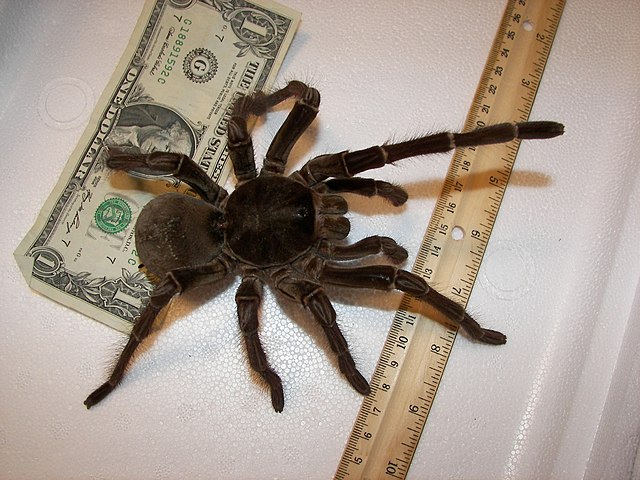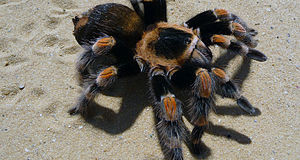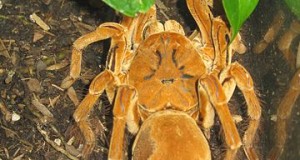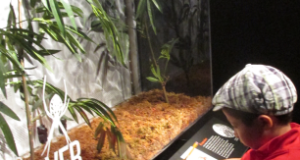Among the world’s 900+ tarantula species (Family Theraphosidae) we find spiders of every conceivable size, description and lifestyle, some of which make interesting, long-lived pets. I had the chance to work with many during my zoo career, and most of the supplies that I relied upon are now readily available to hobbyists. Whether you are just starting out or looking to add additional species to your collection, the following information will assist in your decision. Please be sure to post any questions or observations about pet tarantulas below.
Housing
Setting up the Terrarium
Tarantulas are best kept in screen-covered aquariums, reptile cages or plastic terrariums. “Extra high” styles are best for Pink-Toed Tarantulas and other arboreal species. Be sure to use cage clips on the cover, as tarantulas can climb glass and are incredibly strong. A 10-15 gallon aquarium is adequate for all but the largest individuals.
All tarantulas require a dark hiding spot. Burrowing species such as the Goliath Bird-Eating Spider will dig their own caves if provided deep substrate. Sri Lankan Ornamental Tarantulas and other arboreal species will utilize the underside of an upright piece of cork bark. Most also accept inverted flower pots and plastic reptile caves.
Many tarantulas, especially arboreal species such as the Pink-Toed Tarantula, show themselves to their best advantage in complex, planted terrariums. A wide variety of live plants is suitable for use with tarantulas; please post below for further information.
Substrate
A mix of coconut husk, top soil and peat moss works well for Cameroon Red Tarantulas other rainforest natives. For burrowers such as the Thailand Black Tarantula, add just enough water so that the substrate sticks together when squeezed…keeping it so will help to prevent the burrow’s walls from caving-in.
Tarantulas that are native to arid habitats, such as Mexican Red-Knees, can be kept on a sand-gravel substrate.
Heat
Most tarantulas will thrive at temperatures of 77-86 F (please post below for specific information, as needs vary among the different species).
Red/black reptile night bulbs or ceramic reptile heaters can be used to warm the terrarium. These bulbs will not disturb your spiders and so will allow you to watch their nocturnal activities.
All heat sources will dry out the terrarium, so it is important to monitor humidity (see below)
Humidity
Proper humidity levels are critical to good health, normal activity and successful shedding. Please do not overlook this important facet of tarantula care. A humidity gauge is an essential piece of equipment for the serious tarantula keeper.
Tropical forest species such as the Sun Tiger require humidity levels in the range of 75-85%, while Chilean Rose-Haired Tarantulas and others from arid habitats do best at 40-50% humidity. Desert-dwelling tarantulas spend most of their time in burrows, where the humidity is high, and should be provided a cave stocked with damp sphagnum moss.
Humidity can be increased by misting, adding water to the substrate, maintaining a sponge in a bowl of water, utilizing a small reptile humidifier and/or partially covering the terrarium’s lid with plastic (be sure to maintain air flow as well if you use plastic covers; please post below for details).
Tarantulas become lethargic a day or so before shedding their exoskeleton; the terrarium’s humidity should be increased at this time. Most produce a silken mat on which to molt, and complete the process at night, while lying on their sides or backs. Do not attempt to right a tarantula that you find in this position, and do not disturb or feed your pet for several days after it has molted.
Food and Water
Most tarantulas will thrive on a diet comprised of crickets, mealworms and earthworms. I’ve always offered wild-caught insects, roaches, waxworms, and other invertebrates as well, and believe this is key to the long term health and breeding success of some if not all species. Canned grasshoppers and other invertebrates moved about with a long-handled forceps (remember, tarantulas have poor vision and may strike well above the food item – do not risk a bite!) are an excellent source of dietary variety.
Although wild tarantulas of some species frequently capture frogs, lizards and the occasional small rodent, vertebrate prey is not required for captives. An occasional pre-killed pink mouse may benefit Goliath Bird-Eating Tarantulas, however, especially if breeding is contemplated. These voracious predators will readily accept dead prey moved about with a forceps; live mice should not be offered.
Tarantulas obtain water from their prey, but should also be provided with a shallow water bowl. The enclosure should be misted daily.
Further Reading
Tarantula Care and Natural History
Beyond Webs: Swimming, Spitting and other Unique Spider Hunting Strategies
 That Reptile Blog – Reptile, Amphibian and Exotic Pet Care and Information
That Reptile Blog – Reptile, Amphibian and Exotic Pet Care and Information







Hallo Frank
I have captured a wild horned baboon spider recently.
It unfortunately had only 7 legs but never the less I decided to keep and observe this beautiful spider that roam wild in our “back yards”.
After its first shedding, a second leg got “lost” but the creature still kept on living an apparent normal life.
The surprise how ever came when it shed a second time in captivity but with 2 new legs!!!! Or at least the legs are present but seem to be dysfunctional…
I will keep further note and try to report in between.
Kind regards from Namibia
Gert
Hi Gert,
I hope all is well..very interesting, thanks. I don’t recall seeing 2 legs replaced at once – quite a drain on the spider, it must be eating well! What is it’s diet? Look forward to updates, best, Frank
Hi Frank
I saw the new legs are moving individually but to a limited extend.
Diet is mainly huge cockroaches (almost the size of the spider it self).
But I only feed when I see the spider gets restless and that’s about once a week or even once in two weeks.
How ever, the water is regularly filled.
In the meantime we collected a tiny (8mm only) baby scorpion (predictably a parabuthus species) as well and we want to see how far we can raise this little guy….
Best regards
Gert
Thanks, Gert, enjoy and please keep me posted,. best, Frank
Hello Mr. Indiviglio,
I’m sure over the years you’ve kept many tarantulas both at home and in the Bronx Zoo, but have you ever heard of anyone, either professional or hobbyist, getting bitten and having an allergic reaction to tarantula venom? I brought home a Chilean Rose yesterday as my first tarantula and this seemed to be a concern with regards to handling it.
Also, could you give my any tips or advice on this species care? Right now it’s living up to it’s reputation as being a “pet rock”. I don’t think I’ve seen it move at all. Thanks!
Cheers, Alex
Hi Alex,
The venom of any tarantula or other spider can cause serious allergic reactions; as with other allergies (bee venom, etc) fatalities could result. As we know very little about tarantula venom, treatment may be difficult. There is also evidence that some species, and even populations within certain species, produce venom that is more powerful than that of others. Another concern is the hairs, which are hard to see and can easily find their way into eyes, nasal membranes etc long after a tarantula has been handled. A former co-worked of mine, well experienced, had to undergo several serious cornea operations in order to remove the hairs of a :harmless” species (red knee) from his eye.
Tarantulas should never be handled. Move as described in this article (article has 2 parts) if need be. They cannot be tamed, trained, or made to respond to people. Anything you read on the internet to the contrary is dangerous advice and should be ignored.
The species you have burrows in the wild, but will utilize a cork bark or similar shelter in captivity. A sand/gravel mix suits it well. It is adapted to arid environments and does well at 75-80 F; temps can dip at night. Mist lightly each day, and provide a shallow water bowl. Be sure the top is secured with clamps, as they are quite powerful. The diet should be comprised of crickets, roaches and other invertebrates.
Red/black night bulbs will help you to observe it after dark.
Please let me know if you need further info. Best, frank
Thank you for the lesson, I’m deathly scared of spiders so hopefully I won’t have to handle it all that much. I do hope that it’ll help me get over my arachnophobia though. How often should it be fed? I’ve read everything from once a day to once a month. Also, how does one measure a tarantula? I know most hobbyists use the diagonal method but should it be with the legs flattened or held by the body? I appreciate the help!
Cheers, Alex
Hi Alex,
Arachnologists have standard measuring protocols, but I’ve never had to do so. I would not advise measuring…again, urticating hairs will be dislodged (either by the spider or via general movement) and they may wind up in your eyes…they are thin, and hard to see; also, difficult to avoid a bite unless one is well experienced.
Food intake depends upon age, temperature, diet itself, and other factors, but spiders can regulate their metabolisms in tune with food availability. An adult might take 3-5 crickets per week, in one feeding or several; less as it puts on weight, nears maturity. They usually cease feeding prior to a shed.
Here is some info on Snake/Spider Fear.
Best, Frank
Hallo Frank
Thanxzzz once again for your valuable information!
I keep on forgetting to ask: are “loosing” hairs a defence mechanism of these spiders?
Regards
Gert
Hi Gert,
Thanks for the kind words, and also for sending the spectacular rock python photos; sorry I did not get back to you on that.
The hairs are defensive, get into eyes, mouths etc.; some species more inclined to shed than others.
In Venezuela, I saw a 17 foot long anaconda take a 60 lb deer (weighed the meal when it was regurgitated after the snake was captured); It looks like the wildebeest in those photos is even heavier.
Here are 2 related articles: http://bit.ly/cNdWIg http://bit.ly/zgBNag
I hope all is well, Frank
I know this is not the correct thread for snakes…but WOW!!!…I still need to fully gulp in those two articles…lol
In the mean time I still am searching for another article of a zebra cobra (naja nicricollis) that is swollowing a huge minitor Lizard…
Thanks for keeping up your really good work.
Regards
Gert
Much appreciated, Gert! Let me know what you find…
Best regards, Frank